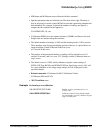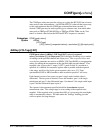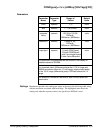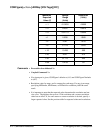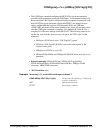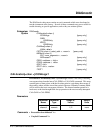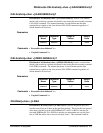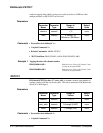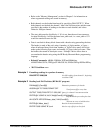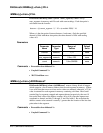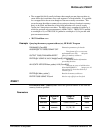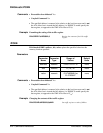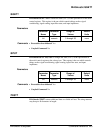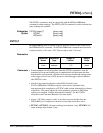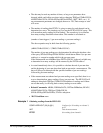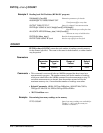
• Refer to the "Memory Management" section in Chapter 3 for information on
where segmented readings are stored in memory.
• Both channels can be fetched interleaved by specifying DIAG:FETC3?. When
both channels are fetched, the channel 1 data is the first data point, and the count
specified is the number of readings to be taken on each channel, and is thus
limited to 1000 per channel.
• The start_addr must be divisible by 4. If it is not, then the next lowest memory
location divisible by 4 will be the actual start_addr used, i.e. a start_addr of 511
would be rounded down to be 508.
• Data is sent back in binary block format with a header string preceeding the data.
The header is made of the ascii string: #,number_of_digits,number_of_bytes --
where # indicates binary block data, number_of_digits is how many ascii digits
make up the following byte count, and number_of_bytes is the byte count. After
the header, the stream of data bytes occurs. Example 2 below shows how to
accomodate the header string using the HP Rocky Mountain Basic programming
language.
• Related Commands: ABORt, FORMat, INITiate:IMMediate,
ARM:STARt:COUNt, TRIGger:STARt:COUNt, SENSe:SWEep:POINts:DELay
• *RST Condition: none
Example 1 Examining readings in a portion of memory
DIAG:FETC? 5200,300 Get 300 readings from channel 1, beginning
at address 5200.
Example 2 Reading back PACKed data (HP BASIC program)
DIM Ndig$[1],Count$[9] Dimension parameters for header
ASSIGN @X TO 70905;FORMAT OFF
Turn format off for array data
OUTPUT 70905;"DIAG:FETC1? 5200,300" Query for channel 1 measurement data
ENTER @X USING "#,X,K,K";Ndig$;Count$[1;VAL(Ndig$)]
Strip the header preceeding the data
ALLOCATE INTEGER Meas_data(1:VAL(Count$)/2)
Allocate an array to hold the data
ENTER @X;Meas_data(*) Read in the measurement data
ENTER 70905 USING "B";Junk Need to strip off left over line feed
DIAGnostic:FETCh?
DIAGnostic Subsystem Command Reference 219



